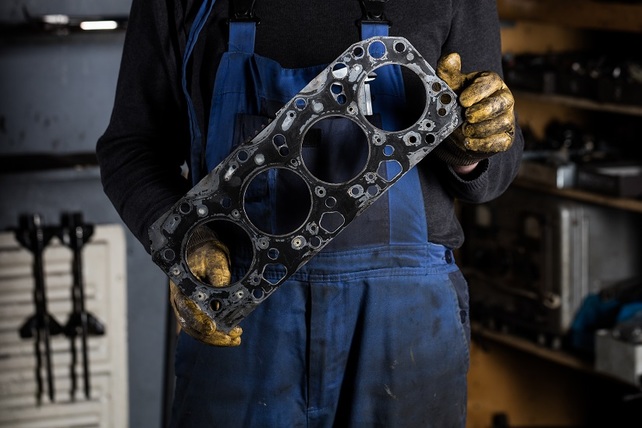
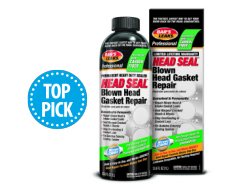 Sealers are, fortunately, an extremely easy and quick fix for leaking gaskets. They work rapidly, and repairs can take as little as an hour, once the sealer is applied and the solution begins to fill any cracks or crevices.
Sealers are, fortunately, an extremely easy and quick fix for leaking gaskets. They work rapidly, and repairs can take as little as an hour, once the sealer is applied and the solution begins to fill any cracks or crevices.
Older engines, in particular, are prone to crack or leaky gaskets, and if you value the products you use on your vehicle, then you may be searching for head gasket sealer reviews to help make sense of the options available to you.
Top 3 Picks
In the interest of ensuring a successful outcome, you should choose a high-quality product that is verifiably reliable. In the following article, we seek to provide you with head gasket sealer reviews, with the intention of helping you find the best fit for your needs.
Bar’s Leak HG-1 Head Seal
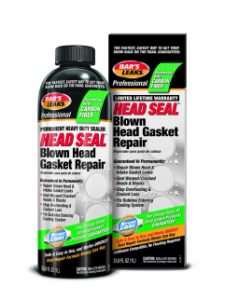
Bar’s is an established, American brand that specializes in providing anti-leak products for cooling systems. Their ‘Head Seal’ sealer is one of the best head gasket sealers, intended to repair blown gasket heads; reinforce cracked cylinders and blocks; resolve leaking plugs and perform other related tasks.
Their head gasket sealer is the strongest available product in the range, best suited to vehicles that typically overheat in 15 minutes and require a strongly blown head gasket sealer. This sealer is compatible with antifreeze, requires no flushing and takes about 45 minutes to function effectively—making it a versatile and practical option for you to consider.
back to menu ↑
Blue Devil Head Gasket Sealer
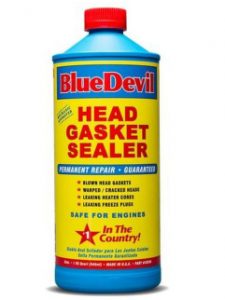
Blue Devil is a reputable brand, that prioritizes the wellbeing of older engines, and in particular those that require a blown head gasket sealer. Their head gasket sealant was specially formulated to contain no unnecessary particles or matter, meaning that this sealer will not clog engines or interfere with the performance of your vehicle.
This product will take an estimated hour to work, and provides comprehensive instructions on how to administer it as effectively as possible.
back to menu ↑
Steel Seal Blown Head Gasket
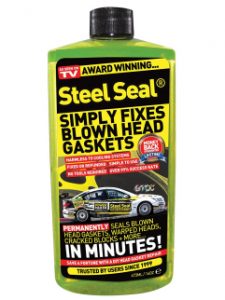
This permanent solution by Steel Seal is one of the best head gasket sealers for those looking to seal any notable cracks in their engine, particularly those that are causing detrimental leakages, as quickly and as effectively as is possible within the realms of DIY.
This sealant can be used on 8-cylinder engines (when specified during checkout) that require a blown head gasket sealer, and features a lifetime guarantee, making it an attractive option for those looking to repeatedly repair temperamental gaskets.
back to menu ↑
K&W Permanent Head Gasket and Block Rep
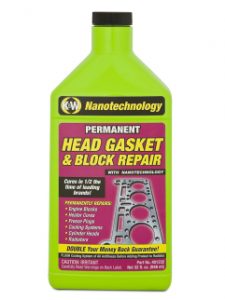
K&W’s head gasket sealant, which features nanoparticles, is scientifically formulated to repair your head gasket using the highest quality ‘ingredients’ available. This head gasket sealant was made using advanced nanotechnology, in the interest of providing the “tightest molecular bond,” and thereby sealing any cracks as fully as possible.
One of the best features of this product is that it doesn’t interfere with the cooling system in your car, or rely on it for that matter, extending the permanence of its efficacy. Depending on your needs, this product is available to resolve issues in 4, 6 or 8 cylinder engines—making it one of the best head gasket sealers for you to explore.
back to menu ↑
Bar’s Leaks Head Gasket Fix
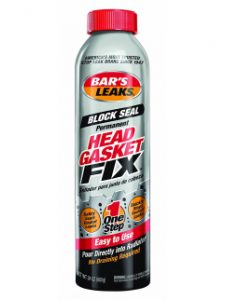
This very simple, straightforward head gasket sealant performs well and offers very few complications in the way of purchasing or administering it to your engine. Interestingly, in their head gasket sealer reviews, many customers claim to use Bar’s Fix as a preemptive measure and treat their cars with it regularly—in the interest of preventing any potential issues from arising in the future.
This head gasket sealer contains carefully measured particles that work to fill any cracks, making this sealant a very reliable alternative for you to consider, particularly if you value high-quality treatments for your car and engine.
back to menu ↑
CRC Permanent Head Gasket Repair
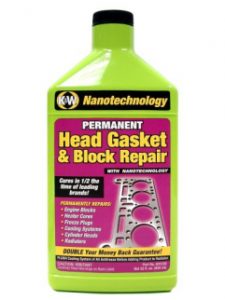
One of the best head gasket sealers, that uses advanced nanotechnology in the treatment of your engine, is CRC’s Permanent Head Gasket Repair. As discussed above, nanoparticles are particularly effective in resolving issues with head gaskets, primarily because they are able to fuse and bond with more strength than larger molecules.
This head gasket sealer was specifically designed to provide strong, durable bonds in your gasket—thereby filling and treating preexisting cracks and preventing more from arising in the future. This is a great blown head gasket sealer, that can be applied to a range of vehicles, including buses and motorcycles. It is also retailed with a satisfaction guarantee, meaning that if it doesn’t perform well on your car, you can demand a refund as compensation.
back to menu ↑
K&W FiberLock Head Gasket Repair
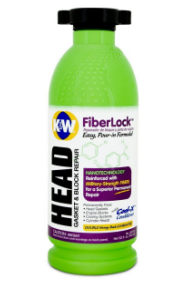
Another viable head gasket sealer for you to consider is K&W’s Gasket and Block repair solution. This is a high-quality head gasket sealant designed to treat a number of issues, including heater cores and coolant leaks, problems with cylinder heads, freeze plugs and head gasket leaks. One of the best features of FiberLock is its comprehensive, easy to follow a set of instructions.
While using a head gasket sealant is relatively easy, this product simplifies the process all the more, making the task of repairing your gasket as fast and painless as possible. This head gasket sealer also features a satisfaction guarantee for you to take advantage of, should it not meet your expectations or fully resolve any issues you may be facing.
All of the above head gasket sealants were chosen in the interest of providing you with a selection of high quality, reliable head gasket sealer reviews for you to consider. When reading head gasket sealer reviews you should, as with any car treatment, ensure that it’s compatible with your engine and that it was designed to treat any issues you may be battling. The head gasket sealants listed in this article are effective, and most effective when used correctly. Therefore, before beginning, you should ensure that you read any instructions thoroughly so as to understand the process completely. Above all, however, it’s most critical for you to choose the best head gasket sealer for you. This means a sealant that is reputable and guaranteed to not damage your engine further—as quality should always take precedence when it comes to engine treatments.
What is a Head Gasket Sealer
First of all, a head gasket is an important piece in any car which separates the engine block and cylinder head. It seals the cylinders to allow for the greatest degree of compression and reduce the leakage of oil or coolant that can get into the cylinders. The head gasket is essentially the most important sealing application which exists in any given engine. If a head gasket gets blown it can create a world of difficulty for whoever owns the car. This is also where head gasket sealant comes into play.
A head gasket sealer can also be called a gasket sealant. It comes in the form of either a spray, glue, or paste, and the purpose it serves it to keep the gasket in place and restrain it from moving. Gasket sealer can also make it less likely for car parts to rub against one another and it will help to reduce a number of fluid leakages you experience. Over time sealants may wear out just like anything else. If you want a sealant which will last longer and work best, then it’s vital to understand what types of sealant are available and which are the best quality. Basically, it’s important to get the best head gasket sealer.
How to Prevent Blowing A Head Gasket
Blowing a head gasket can be pretty bad for your car, needless to say. Thankfully there are certain things you can do in order to prevent this from happening. If you just do a little bit of maintenance on your head gasket then it will probably last as long as you drive the car. Just a little bit of preventative care can go so far, as just about anyone knows who owns a car. Keeping up with regular maintenance may cost money but in the long run, it could save you a small fortune.
Every 3,000 miles change the fluids in your car. This should be done consistently but you can do it from home if you don’t want to take it to an auto shop. One of the most common reasons that people end up with blown head gaskets is simply because they don’t have enough engine coolant. This is an easy thing to avoid if you just keep on top of it.
When you drive don’t accelerate so quickly. Sudden, fast acceleration can bump up the temperature of the engine significantly. This, in turn, may lead to a head gasket either warping or cracking, neither of which are good. Rather than revving the engine the best way to drive is to accelerate slowly and avoid pushing the gas pedal any further than halfway.
If your engine does begin to overhead then pull over. Once again the heat in the engine can lead to a damaged head gasket, so if you know that your car is overheating just turn the engine off so that it can cool down. In some cases, an engine may be consistently hotter than it should be, and this is a problem that should be resolved as it could lead to bigger problems.
How to Use a Head Gasket Sealer
Surprisingly head gasket sealer is very easy and simple to use. There are only a few basic steps to follow and as long as you stick to the directions everything should go smoothly and there should be no issues involved. Using head gasket sealer is something that you can do yourself from home, you don’t have to take the car to a shop or have a professional help you.
The other good news is that, like with anything involving cars, there are directions included. When you do buy head gasket sealer it will certainly come with instructions. These should be simple and easy to read and follow, but to give you an idea of how to use head gasket sealer here are some basic directions that should help.
1. Clean Cooling System
Before you can apply the gasket sealer you should have a cooling system that is free flowing and clean.
2. Take off Thermostat and Flush System
Before using the coolant you will probably need to remove the thermostat then flush the cooling system with some type of flushing agent and then flush again with water.
3. Fill with Water
Pour water into the cooling system but leave enough space for the amount of head gasket sealer which is required. There should be a table which tells you.
4. Engine Must be Cold
Before you actually begin the engine has to be cold, this is very important. The next step is to take off the radiator cap, start the engine, then blast the heater.
5. Slowly Add Head Gasket Sealer
It is very important that you pour the sealer into the radiator very slowly. It should take you around 1 minute to add the whole bottle. Let the car idle for about 50 minutes with the cap on.
6. Finishing Steps
Allow the engine to cool and then install the new thermostat, then drain fluid and add antifreeze.
Ultimately this entire process should not take too long nor require any great degree of effort or skill. As you can see adding head gasket sealer is pretty easy, just carefully read the directions, follow them through exactly how they say, and make sure to follow all safety precautions and warnings. If you add the sealer correctly and you find the right kind then it should help solve some of your problems.






